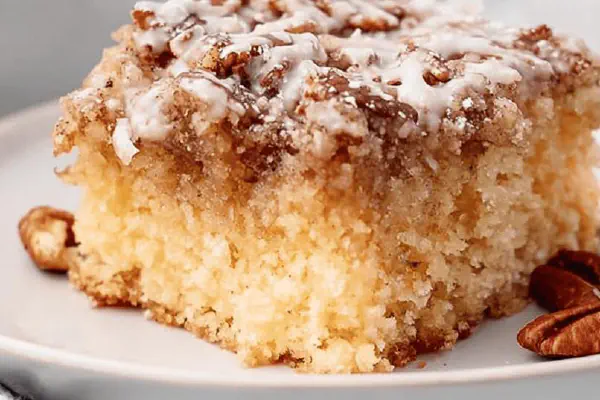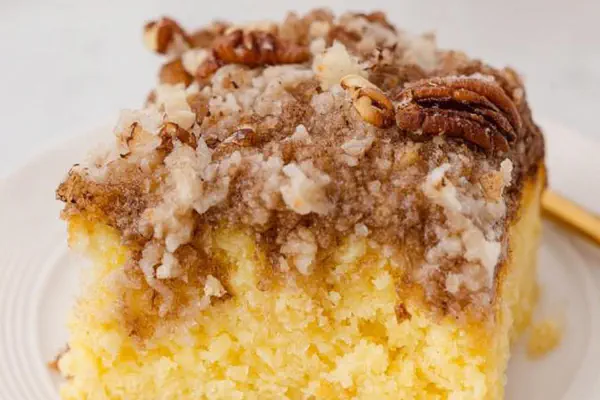Pineapple Cake Coconut Crumb

By Emma
Certified Culinary Professional
Ingredients
- 2 1/2 cups all-purpose flour
- 1 1/4 teaspoons baking powder
- 1 teaspoon baking soda
- 1/2 cup melted coconut oil substitute for butter
- 1 1/3 cups granulated sugar
- 3 large eggs
- 1/3 cup reserved pineapple juice from drain
- 1 1/2 cups crushed drained pineapple (avoid juice)
- 3/4 cup packed brown sugar
- 3/4 cup chopped toasted walnuts instead of pecans
- 3/4 cup sweetened shredded coconut
About the ingredients
Method
- Oven fired to 345 degrees Fahrenheit, light spray 9x13 pan. Let pan preheat slightly with oven - helps batter cling better. No foil trapping steam here or soggy crust.
- Pineapple crushed proper, dump in mesh sieve positioned over bowl. Let it strain juice 10+ minutes - this juice is gold, do not waste. Keeps cake moist, controls soggy fruit fallout.
- Mix dry together. Flour, powders well whisked - aerate. Melt coconut oil till warm but not hot, goes in then sugar and eggs. Hand mixer, careful don’t over whip egg foam or dense chunk. Slowly add pineapple juice from bowl. Batter feels loose but heavy with fruit.
- Fold in pineapple bits gently, uniform distribution keeps every bite textured and wet, not watery. Pour batter in pan. Spread with offset spatula or back spoon, even thickness signals even cook.
- In bowl small combine brown sugar, chopped toasted walnuts, coconut shreds. Toast nuts ahead for deep flavor. Sprinkle topping evenly over batter - heavier on edges so topping doesn’t migrate too much during bake.
- Pop in center rack. Oven hums, sensory alert: edges start light golden crust 28 minutes in, sides shrink subtly, toothpick clean within 5-mm crumb. Center wobble mostly gone but slight jiggle means moist crumb.
- Let rest 15 minutes before slicing. Hot cake falls apart. Crust hardens slight, nutty aroma scorched nuts and coconut bound with caramelized sugar. Slice warm with sharp knife. Cool leftovers tightly wrapped, fridge if you want soft, cover loosely if you like crisp topping.
- Common trap: too wet pineapple ruins inner texture. Drain long, maybe pat excess fruit dry with paper towel. Swap any nuts-pecans, walnuts, macadamia work but toast first. Butter swaps coconut oil for subtle coconut flavor twist, dairy fat replaced but not lost. Sugar tweak according to personal sweetness tolerance.
- Last time I tried foil - soggy crust nightmare. Loose spatula strokes prevent overmixing. Watch batter consistency, pouring slowly better than dumping all liquid at once.
Cooking tips
Chef's notes
- 💡 Drain crushed pineapple thoroughly. Use a fine mesh sieve, let sit 10+ minutes. Even pat dry with paper towels if needed. Juice saved for batter moisture but avoid soggy fruit fallout. Without proper drainage, crumb turns gummy or pasty inside. Hand fold pineapple gently; break fruit too much ruins texture. Keep batter showing weight with fruit chunks but not watery. Watch batter consistency closely. Overwhip eggs lightly or mix too fast means dense cake. Less air better than sponge style here.
- 💡 Brown sugar crust needs packing but not clumpy. Toast nuts beforehand till warm, oil releases aroma, then chop. Mix shredded coconut evenly into nuts and sugar before topping. Spread topping heavier on edges so sugar caramelizes locking crumb while center stays tender. Don’t foil wrap cake while baking — traps moisture, soft crust nightmare. Baking sound cues help: listen for caramel crackle, edges light golden, subtle pull from pan signals near done. Toothpick test critical; expect tiny crumb but no wet batter.
- 💡 Use coconut oil warmed but not hot, temperature matters or mix breaks emulsification. Butter swap alters taste but coconut oil keeps moisture, subtle tropical tone, replaces dairy fat well here. Sugar amounts tweak by personal preference, adjust grams slightly if sweeter or less sweet wanted. Eggs at room temp emulsify batter better. Sift dry ingredients (flour, powders) to aerate and mix powders evenly. Careful to mix wet ingredients slowly. Batter feels loose, heavy with fruit but pourable. Spread with spatula, avoid thick or thin patches for uniform bake.
- 💡 If allergic to walnuts, pecans or macadamia nuts swap freely. Nuts toasted first for crunch, oil release important before chopping and topping. Coconut flakes sweetened or unsweetened change flavor profile; sweetened binds topping better, sharp contrast if unsweetened used. Fresh pineapple preferred but canned crushed with minimal syrup drained longer works too. Drainage really key preventing soggy edges or gummy inside. Watch pan edges pull from sides around 28 minutes, bake closer to 33 min then check again. Center jiggle slight okay but no liquid batter.
- 💡 After baking, rest cake 15 minutes at room temp. Hot cake delicate, cuts crumble prone. Crust hardens slight, aroma of toasted nuts and caramelized sugar comes through. Store leftovers wrapped tight in fridge for soft crumb, cover loosely to keep crisp topping longer. Don’t rush slicing while hot or cake falls apart. Last-minute foil attempts trap steam badly; better loose pan or just spray pan lightly. Watch batter pouring speed; slow incorporation of pineapple juice and liquids prevents overmix rush, keeps crumb texture intact.
Common questions
How important is draining pineapple?
Critical, not optional. Too wet fruit kills crumb texture. Drain in fine sieve 10+ min, pat dry if needed. Juice reserved for batter moisture but separate from chunks. Avoid dumping drained water back in batter or soggy crust happens.
Can I swap nuts or coconut type?
Yes, nuts—pecans, walnuts, macadamia all fair game. Toast before chopping improves flavor and crunch. Coconut flakes sweetened bind topping better. Unsweetened sharper, chewier but less sweetness. Choose based on taste, allergy, or pantry stock. Adjust topping thickness too.
What if cake edges shrink too much or crust soggy?
Edges pulling slight normal—signals done. Too much pull, cake dries out; reduce bake time slightly. Soggy crust means trapped steam—no foil wrap, drain fruit better, avoid foil tenting pan. Use light pan spray only. Baking temperature consistency matters here.
How to store leftovers?
Wrap tight in fridge for soft crumb days later. If topping crisp preferred, cover loosely room temp or fridge but expect quicker softening. Cake can dry if left uncovered too long. Reheat gently or eat cold as personal preference.



